 
Chapter 9
Load-Packer 500 Series
"Cyclomatic"
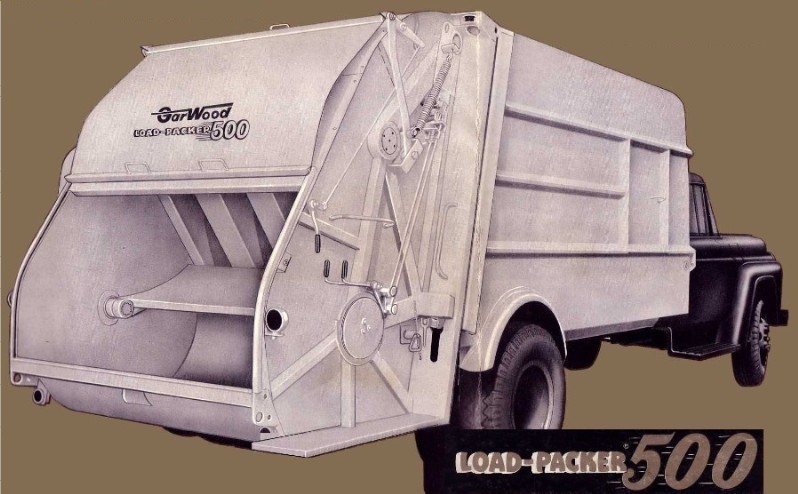
By 1956, the re-designed Load-Packer 200 series was only in its fourth year of production. In terms of sales, it was still the industry leader, and the product of a considerable investment in engineering, tooling, and marketing. In a different time, the LP-200 would have probably been good for a ten-year run, or longer. However, advancements in the industry were occurring so rapidly that Gar Wood could not afford complacency.
Heil Company had introduced the Colectomatic in 1953, an excellent design that had quickly made them a rising force in the industry. Leach also had fielded a redesigned Packmaster for 1955, with the largest hopper in the industry, and the most powerful packer. It would also handle wheeled containers that were becoming popular for commercial stops. Roto-Pac's escalator-packer, which got a bigger loading boot for 1956, was consistently locking-up DSNY contracts and effectively killing Gar Wood's new Speed-Packer. The Dempster Dumpmaster, E-Z Pack Hydro and Bowles front loader joined a surging Pak-Mor to add to an increasingly crowded field. It is hardly surprising that Gar Wood decided to replace their LP-200, which was essentially a twenty year-old design.
A replacement for the LP-200 was being tested by late 1956. The first exhibition of the new Gar Wood rear loader took place ay the American Public Works Association 63rd annual Congress, held at Fort Worth, Texas during September of that year. Dubbed Load-Packer X-516, the experimental model was displayed at the equipment show, one of the biggest in APWA history. Plans were made for production to commence early the next year.
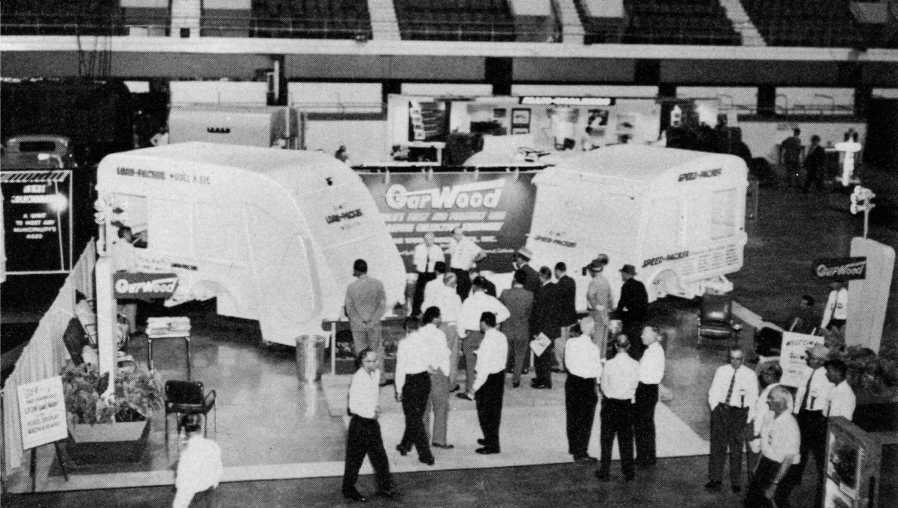
Attendees of the APWA Convention inspect a prototype Load-Packer X-516 (left) in September of 1956.
The new Load-Packer was a team effort led by Gar Wood's Joseph Gwinn (who had designed the SP-400), along with Angus O'Brien and Gerald Coleman. Their collaborative patent no. 2975913 was filed on January 22nd, 1957. The new loader was literally revolutionary, in that it featured a revolving conveyor panel, turning 360 degrees through the hopper to sweep and lift the load up to frame level. Power was provided by a hydraulic motor and chain drive, and the conveyor was fully reversible. A pivoting packer panel, powered by robust 7" hydraulic cylinders, swept refuse from the conveyor into the body, and effected packing action as the body filled. The entire packing cycle was fully automated, requiring the operator to simply hold down a lever momentarily to start. Two cam wheels, driven by the rotating conveyor, controlled linkages directly connected to valves in the hydraulic system. Gar Wood called the new system "Cyclomatic".
Load-Packer 500 was officially launched in March 1957, complete with a nationwide advertising campaign. "The Biggest News in Load-Packer History" read the banners from preview ads appearing in February, and this claim was not inflated. The LP-500 was truly revolutionary, and a complete engineering departure from anything Gar Wood had ever produced. Four models comprised the 500 series, leading with the LP-520 and LP-516 (twenty and sixteen yards respectively), and two smaller models, the LP-510 and LP-513. The latter were shorter in overall height, and their tailgates were not interchangeable with the LP-520/516. The 24-cubic yard bodies were not carried over to the 500 series. This was most likely due the dramatic increase in compaction over the previous models, allowing the new 20-yard models to carry the same amount of refuse (or more) than the LP-324.
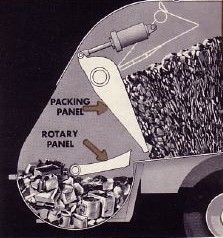
Before start of cycle, refuse is loaded into the hopper below the rotary (conveyor) panel. Any previously loaded refuse is retained within the body by the packing panel.
|
 Operator pushes down on outer control lever, which starts the automatic packing cycle. A valve opens sending fluid to a hydraulic motor, which causes rapid rotation of the conveyor panel through a double-reduction chain & sprocket arrangement located on the left side of the tailgate. Twin cam wheels (not shown) are fastened to the right side stub shaft, which automatically control the valves operating the conveyor and packer panels.
Operator pushes down on outer control lever, which starts the automatic packing cycle. A valve opens sending fluid to a hydraulic motor, which causes rapid rotation of the conveyor panel through a double-reduction chain & sprocket arrangement located on the left side of the tailgate. Twin cam wheels (not shown) are fastened to the right side stub shaft, which automatically control the valves operating the conveyor and packer panels.
After the conveyor panel has rotated about ninety degrees, two hydraulic cylinders above the packing panel energize, and begin to open the panel. At 180 degrees rotation, the packing panel is fully opened as the conveyor moves past the loading sill. Elapsed cycle time to this point is only 4-seconds. After this point, reloading of the partially cleared hopper may now commence, even as the cycle continues.
|
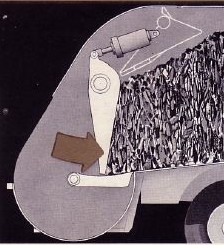
The conveyor panel continues its rotation, sweeping refuse from the hopper and lifting it to floor level behind the opened packing panel. Upon completion of a full 360-degrees travel, the hydraulic motor is de-energized and rotation stops. A set of one-way latches, on either side of the hopper lock the conveyor panel in this position, preventing it from falling back downward.
Packing panel then moves inward, sweeping refuse from the conveyor panel and into the body. The massive 7-inch cylinders exert 81,000 pounds force on the load.
|
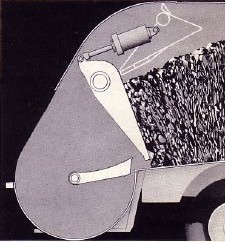
Compression of the load occurs as the body becomes filled. With the fully extended packing panel now retaining the load, the hydraulic cylinders are de-energized. Finally, the cycle ends with the conveyor panel automatically moving a few inches upward, to a "blocking" position. This prevents to prevent the packing panel from creeping backward in between packing cycles.
Elapsed time for this complete packing cycle is a mere 10-seconds.
|
The new Load-Packer was quite impressive in operation, especially in its amazing speed; the rotary conveyor panel would pass by the hopper sill in a mere four seconds, after which the crew could begin re-loading refuse into the hopper. Total cycle time was only ten seconds, the fastest in the industry had ever seen, and ever would. The ability to re-load before the cycle finished was a major improvement over the old LP-200, which had required operators to wait for the complete cycle to end before re-loading. Among batch-type loaders, only the LP-500 and the Leach Packmaster had this feature, and the Gar Wood was 3-4 times faster.
Of course, the continuous-loading Roto-Pac could be loaded as fast as its escalator could carry away refuse, but it suffered from an extremely cramped loading boot, making it difficult for more than one crewman to load at a time. The LP-500 had a 75" wide hopper opening, best in the industry, and could accommodate two or three loaders at time with ease. The 500's spacious hopper held 1.5 cubic yards, and could be equipped with the new Load-Lift container attachment, which hydraulically emptied a one-yard wheeled Pax-All container in seconds. Here again, Gar Wood's closest competitor was Leach, but their Packmaster relied on the packer blade to hoist containers, which was notoriously slow at around 28 seconds cycle time.
Economy of operation was another feature of the new Gar Wood. The short ten-second cycle resulted less time operating the engine at accelerated speeds, which saved on fuel. Hydraulic pressure during the cycle peaked at about 1,050 PSI, which reduced damaging heat within the system. Competitive packers operated with pressures as high as 1,700 PSI.
If the LP-500 had any drawbacks, it would be in its chain driven conveyor panel, which limited its ability to crush bulky objects. Here, the Leach Packmaster reined supreme among rear loaders. However, crushing ability was not necessarily a high demand feature in a rear loader in 1957. The LP-500 was an excellent residential refuse packer, especially with the loose makeup of the refuse stream in the days before plastic sacks. The chain drive was subject to a somewhat high degree of wear, but was at least protected from the refuse and easily repaired in the field in most cases. In the years to come, as more and more was expected of a rear load packer, the limitations of the design would become more pronounced. Nevertheless, the Cyclomatic Gar Wood was to prove highly popular over a long production run, spanning more than twenty years.
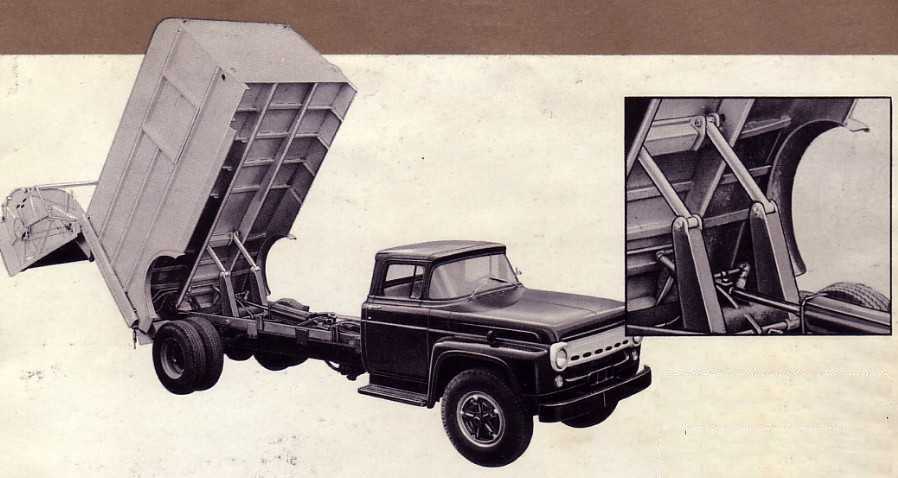
LP-500 had the highest dump angle of any refuse collection body on the market. Gar Wood Twin-Arm underbody hoist provided maximum stability on uneven dump site surfaces.
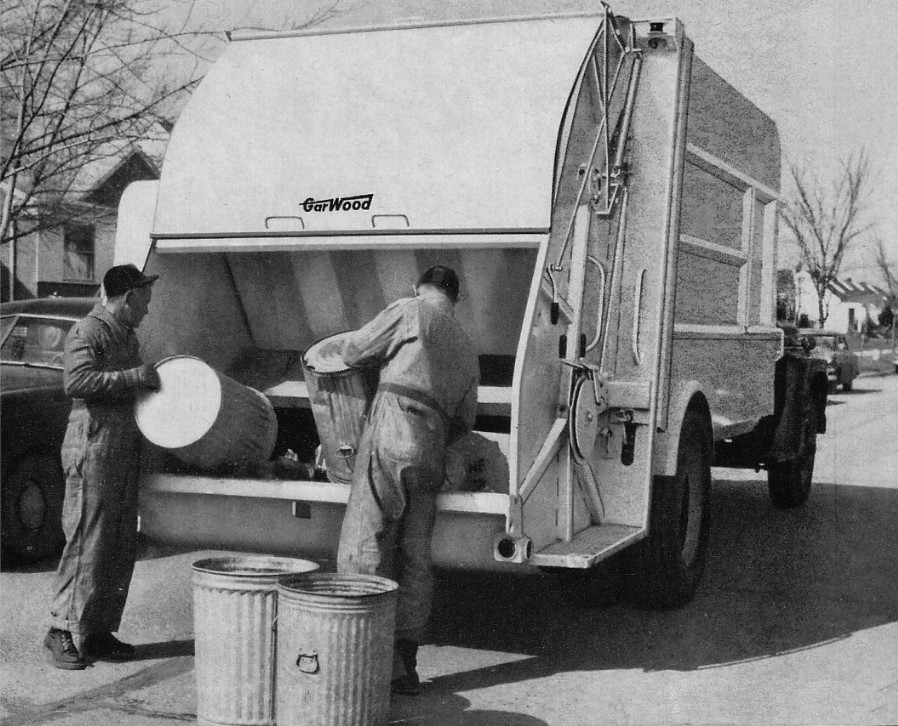
75" hopper width on LP-500 was best in the industry, and would easily accommodate two or three loaders. Hopper sill height was extremely low on most chassis installations. Note the twin cam wheels on the right side of hopper wall, which are driven by the conveyor panel stub shaft. These cams automatically control the complete packing cycle.
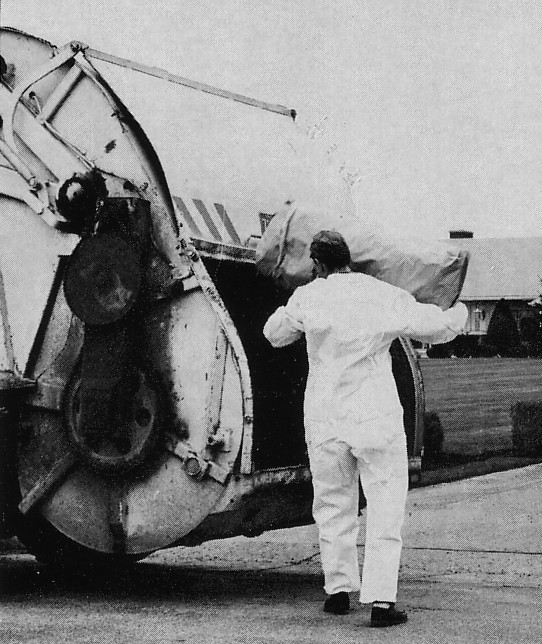
A missing chain cover on this LP-500 offers a view of the left-side conveyor panel drive. The drive chains and sprockets, along with their protective cover, protruded significantly from the left-side hopper wall. Within a few years, subsequent models used an improved drive with a much more compact profile.
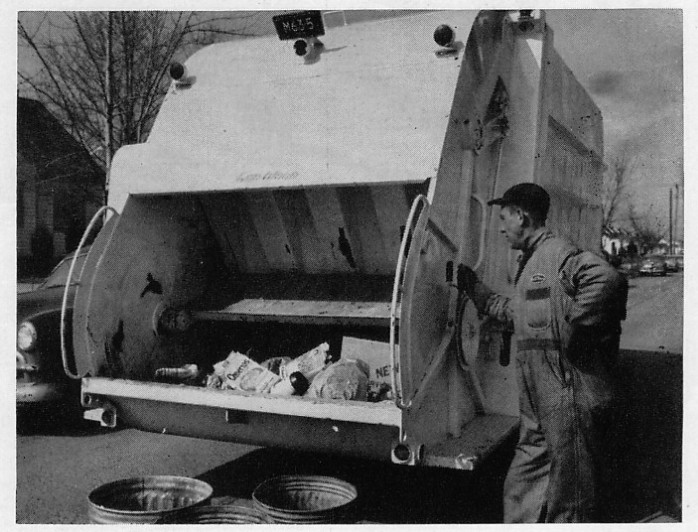
Pushing down the outside lever to start the automatic packing cycle. Note the conveyor panel in the "blocking" position in front of the packing panel. This prevented jam-ups if the packing panel crept back between cycles.
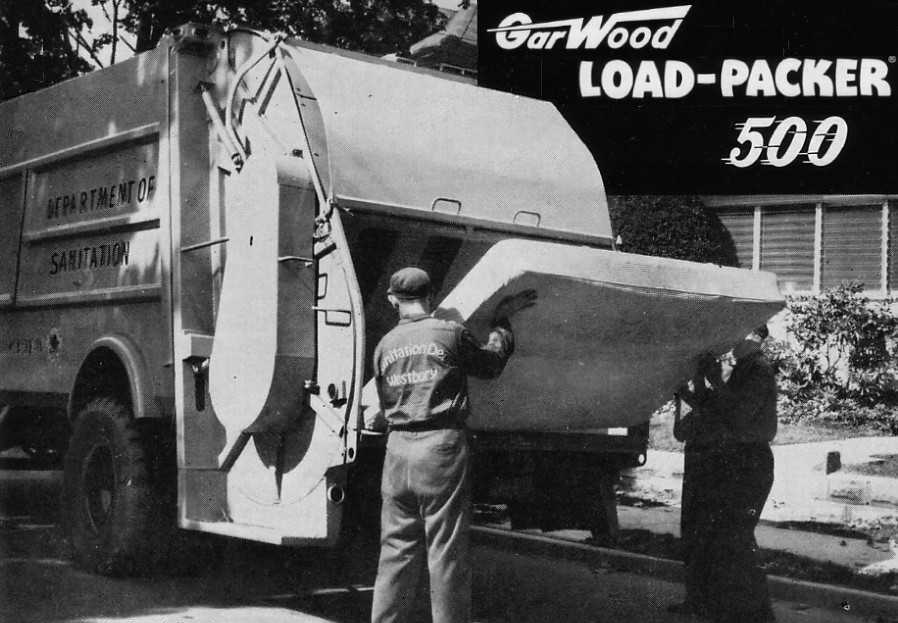
Westbury, NY Sanitation Department crewman feeding a mattress into their LP-520. Despite this confident advertising photo, the chain driven conveyor panel was not well-suited to crushing bulking objects such as crates and appliances.
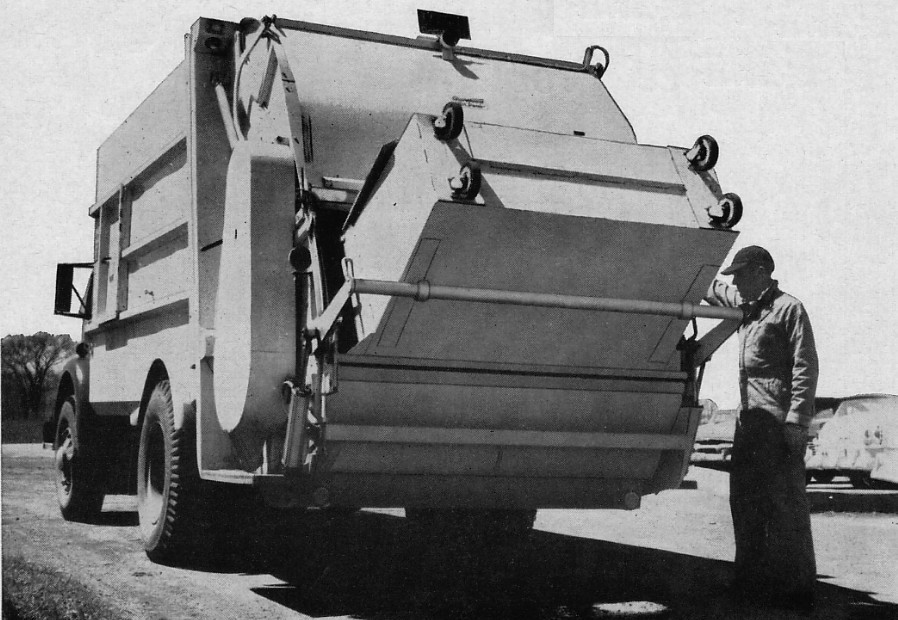
Gar Wood's previous model LP-200 was not adaptable to handle wheeled containers, due to its protrusive ram-door packer blade. But the LP-500, with its wide, unencumbered hopper opening, was ideally suited for the optional Load-Lift, a "kick-bar" hoist for servicing 1-yard Pax-All bins. Two small hydraulic cylinders on the sides of the hopper powered the bar, which upended the containers. With its lightning-fast packer, the 500 was a highly efficient container truck, especially compared with the Leach Packmaster, which relied its slow-moving packer blade to raise and dump containers.
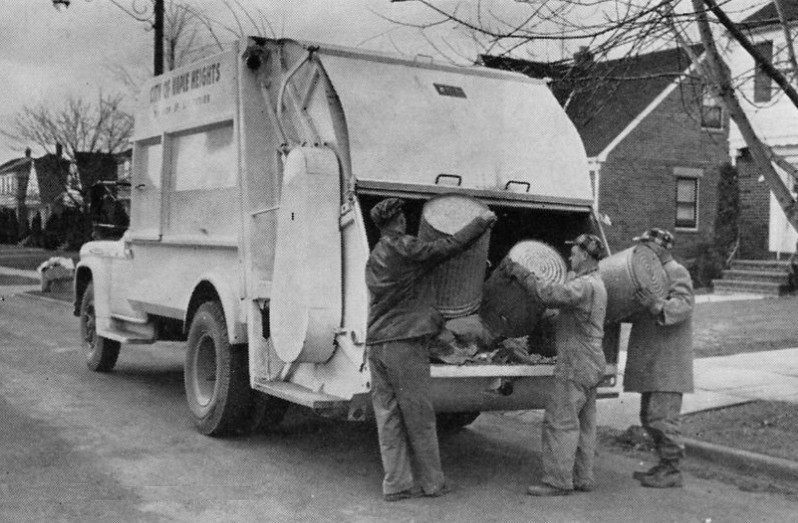
As with many American cities, Maple Heights, Ohio was already using Gar Wood Load-Packers when the LP-500 was introduced.
They added this LP-516 to their fleet and found that it finished its routes up to 1.5 hours faster than their LP-200s.
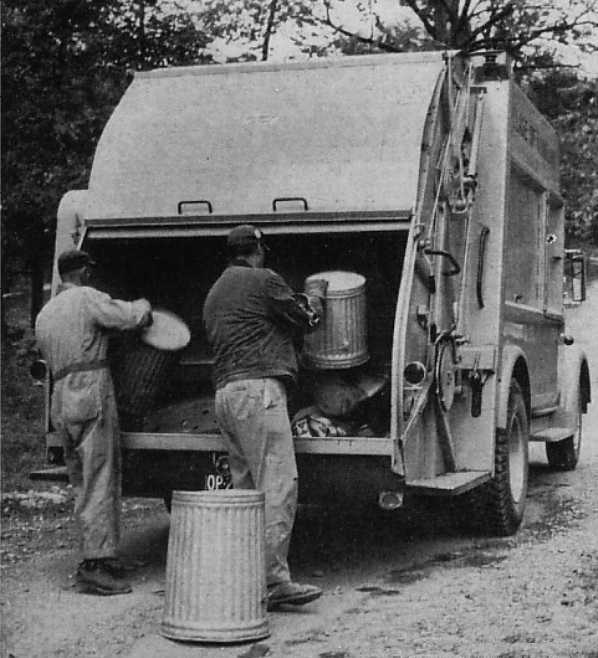
Even small communities benefitted from the 500's efficiency.This LP-516 purchased by Woodlawn, Ohio served only 650 customers per week. It replaced an open-type truck, and cut the work day from 10 to 7 hours per day, eliminated two landfill trips per day and one extra crewman. The Village cut the cost of collection per family nearly in half, and improved operator comfort.
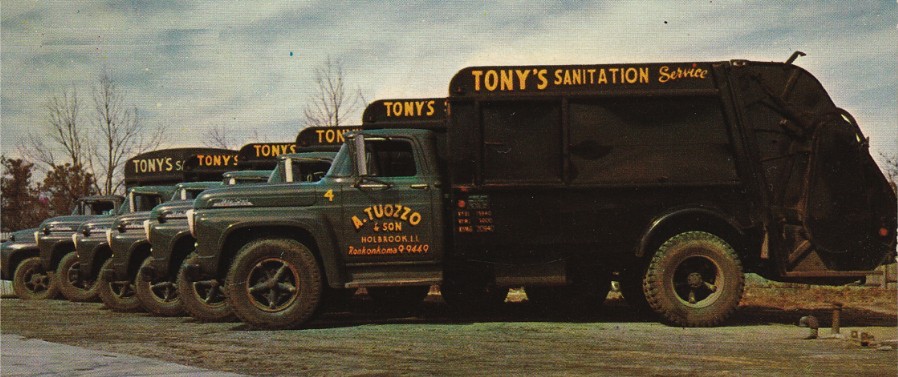
This Long Island contractor had a fleet of six Load-Packers, including four new LP-513s. The compact LP-510/513 models were only 74" tall, compared to 81" and 82" heights on the LP-516 and LP-520, respectively.
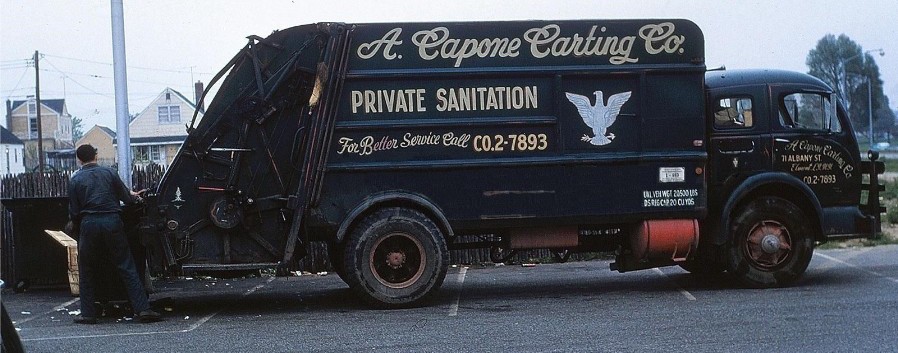
Capone Carting of Elmont, L.I. operated this full-sized LP-520 packer mounted on a White 3000 tilt-cab. Here, the operator is shown attaching a one-yard Pax-All wheeled container to be hoisted over the hopper.
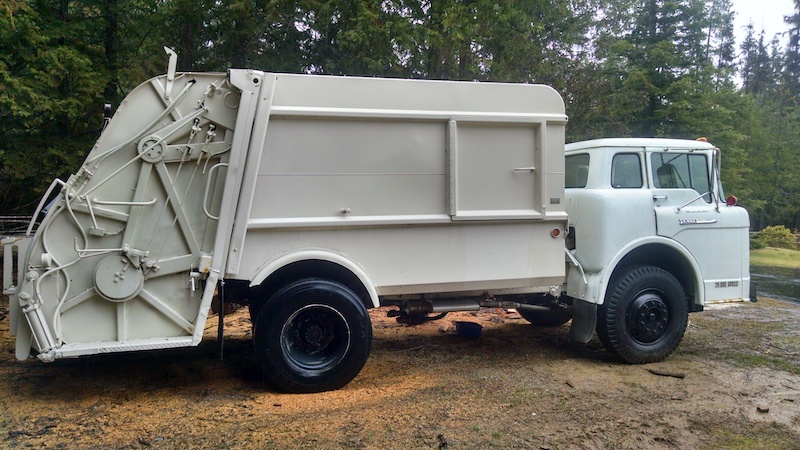
Preserved Gar Wood LP-513 in working condition, owned by the Waste Pro Museum of Sanford, Florida
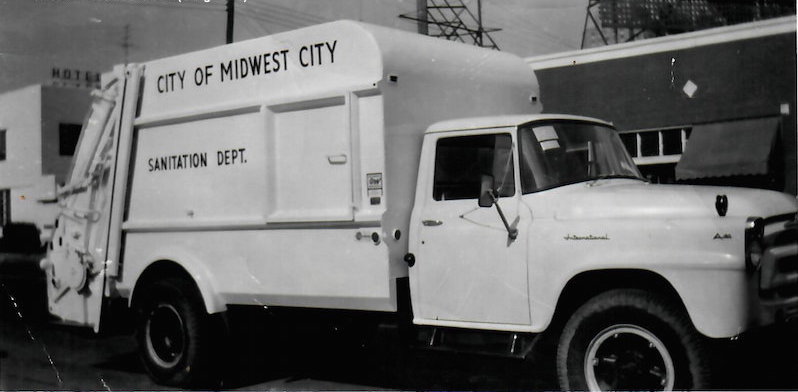
The City of Midwest City, Oklahoma took delivery of this International A180 with LP-500 body in July, 1957
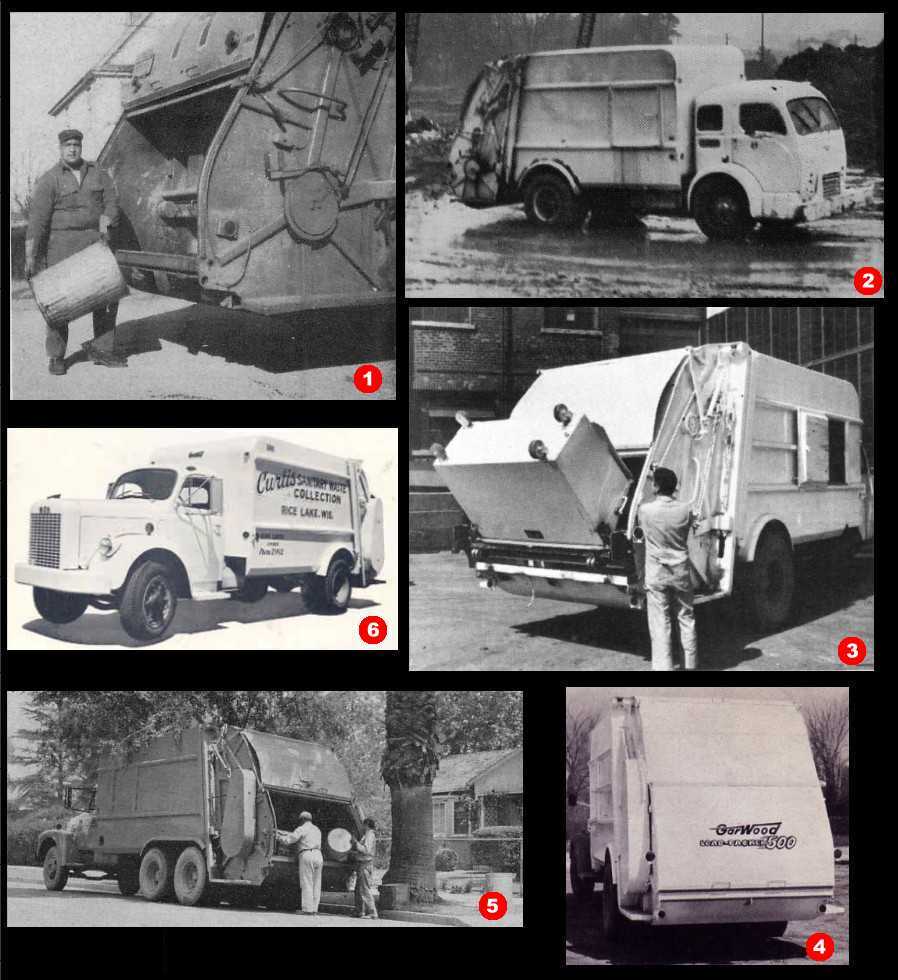
Clockwise from top: (1) One of 15 Gar Woods belonging to East Meadow Sanitation Service, East Meadow NY, (2) City of Detroit LP-516 on White cabover, (3) LP-520 tipping a 1-yard Pax-All container, (4) LP-516 demonstrator with rear hopper door closed, (5) City of San Fernando, California LP-520 on tandem-axle International chassis, (6) LP-513 on REO truck chassis owned by Curtis Sanitary of Rice Lake, Wisconsin
|
SELECTED PATENTS
|
Patent # |
Description |
Inventor |
Assignee |
Date |
|
US2879906 |
Refuse Loader |
Gwinn |
Gar Wood |
January 22, 1957 |
|
US2975913 |
Refuse loader control mechanism |
Gwinn, et.al. |
Gar Wood |
January 22, 1957 |
|
US3032216 |
Container dumping attachment for refuse trucks |
McCarthy |
Gar Wood |
March 28, 1958 |



7/30/14
© 2014 Eric Voytko
All rights reserved
Photos from factory brochures/advertisements except as noted
Logos shown are the trademarks of respective manufacturers
|
|
| |